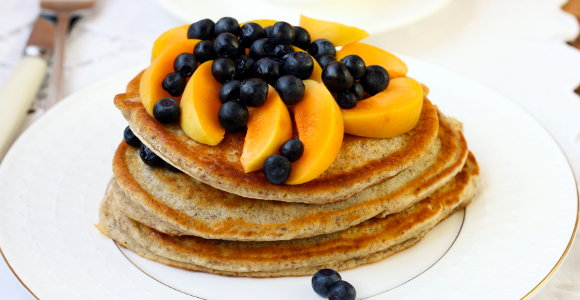Does your family love pancakes but you're concerned about the poor nutritional profile? Do you save pancakes for a special treat because your kids load on the syrup and butter and you know an 800-calorie breakfast is not good for anyone? Before putting pancakes into the nutritional no-no category, take a moment and re-evaluate your pancake recipe and toppings. With a few substitutions, eliminations, additions and no extra time, pancakes can fit into a well-balanced, heart-healthy diet.
Original Pancake Recipe
Yields 4 Servings
- 1 cup all-purpose flour
- 1 teaspoon white sugar
- 1 teaspoon baking soda
- 1 teaspoon salt
- 1 cup 2% milk
- 2 large eggs
- 1 teaspoon vanilla extract
- 1 tablespoon vegetable oil
- 1 teaspoon margarine, softened
FitDay Approved Recipe
Yields 4 servings
- 1 cup whole grain flour
- 1 teaspoon cinnamon
- 1 teaspoon baking soda
- 1 teaspoon salt
- 1 cup skim milk
- 1/2 cup Egg Beaters or 2 egg whites
- 1 teaspoon vanilla extract
- 1 tablespoon canola oil
- 1/4 cup flaxseed mill
- Nutritional Information* (serving size = 1 pancake)
Original Pancake Recipe
- Calories 227
- Protein 8 g
- Fat 8 g
- Saturated Fat 2 g
- Sugar 4 g
- Cholesterol 111 mg
- Sodium 966 mg
- Fiber 1 g
FitDay Pancake Recipe
- Calories 204
- Protein 11g
- Fat 6g
- Saturated Fat .5 g
- Sugar .5 g
- Cholesterol 1.5mg
- Sodium 987 mg
- Fiber 6g
Directions
- In a bowl, stir together flour, cinnamon, salt, flaxseed meal and baking soda.
- In a separate large bowl, beat together egg beaters, milk, vanilla and canola oil.
- Stir dry ingredients into egg mixture and mix until smooth.
- Lightly grease a griddle or frying pan with non-stick cooking spray over medium heat. Pour or scoop approximately ¼ of the batter for each pancake onto pan or griddle.
- Brown on both sides!
The toppings you add to pancakes are just as important as the ingredients you mix together to make pancakes. Syrup, butter, and fruit-based toppings were not included in the above nutritional calculation. So while 200 calories per pancake may seem reasonable, it is easy to double or triple the caloric load with toppings. So ask yourself; how much syrup and butter do you put on your pancakes? A 1/4 cup serving of regular maple syrup adds 200 calories and 93 grams of sugar while sugar-free syrup only contains 20 to 35 calories per ¼ cup. A tablespoon of butter contributes 105 calories and 8 grams of saturated fat, and it's easy to use more than one tablespoon.
Another calorie and sugar trap can be pre-prepared and processed fruit sauces and blends. Frozen fruits with no added sugar and fresh fruits are much healthier alternatives. In order to avoid portion distortion with your pancake toppings, always measure! Use a measuring device and make sure you know exactly how many calories and other nutrients you are adding to your "fluffy friends."
*Nutritional information is only an estimate.
Laura N. Kenny is a Registered Dietitian and Certified Dietitian in the state of Indiana. She received both her Bachelor of Science degree in Dietetics and completed her dietetic internship at Purdue University. She is currently pursuing her Master of Science degree from Central Michigan University. Laura works for the Indiana Obesity Center PC under the supervision of Dr. Keith McEwen. She specializes in both surgical and non-surgical weight loss including nutritional adherence, meal planning, and macro/micro nutrient status. Kenny also promotes healthy eating through various speaking engagements throughout Indianapolis and teaches indoor cycling and Pilates classes in her free time. Since staring her dietetics career, she has worked with a variety of populations and chronic diseases. Each summer Laura volunteers at Camp John Warvel, a camp for children with diabetes. She also enjoys writing, sports, exercise, and reading "hot topics" in nutrition. Laura has a true passion for guiding people to choose healthy nutritional choices for each and every individual lifestyle. To contact Laura, email her at [email protected].



